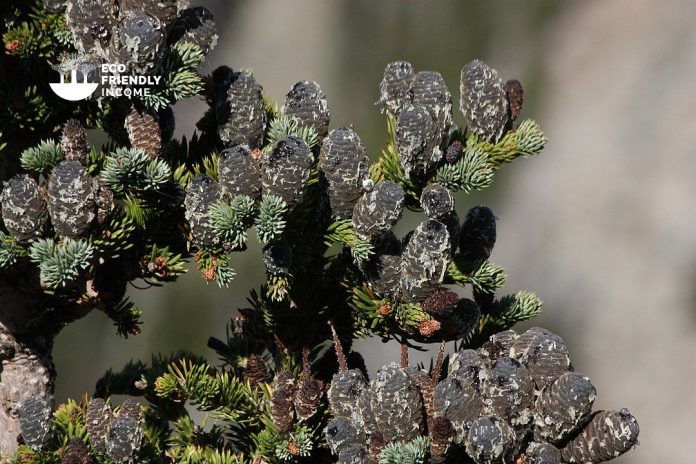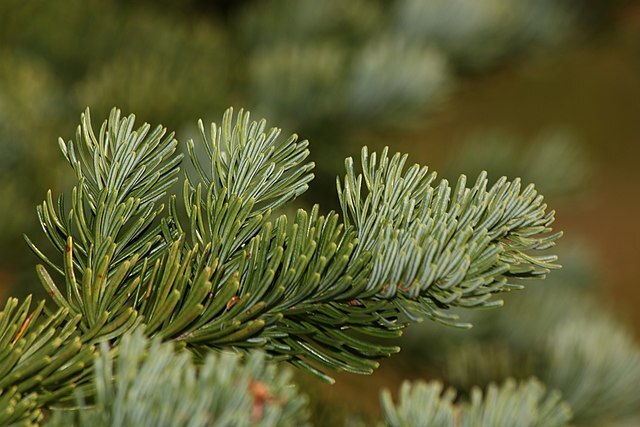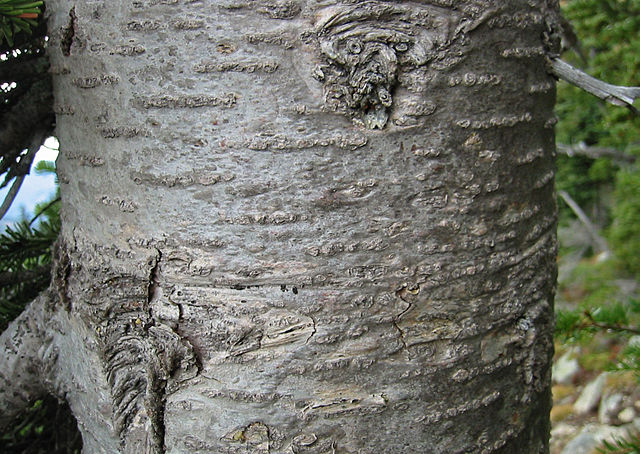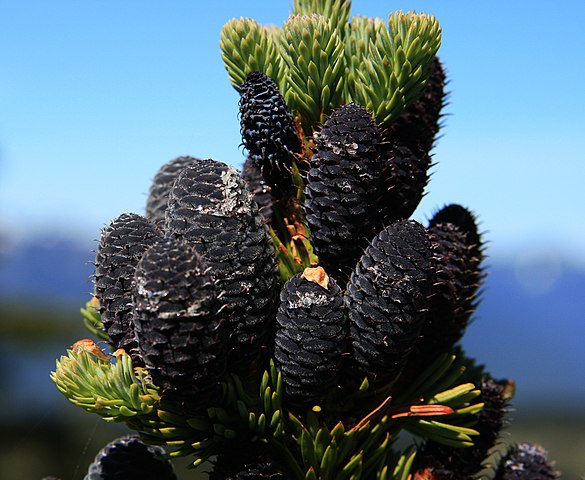
Featured Photo by Walter Siegmund / CC BY-SA 3.0
A field guide on how to identify and propagate Subalpine Fir (Abies lasiocarpa), a hardy tree that is native to the mountains of western North America.
How to Identify Subalpine Fir (Abies lasiocarpa)
Leaves

Subalpine fir needles are linear-shaped, with entire margins (smooth). They grow on the stems in alternate arrangements.
The needles have a rounded or notched tip, are flattened and two-sided, and feature white-grayish undersides.
Subalpine fir needles measure approximately 2 cm in length each.
Bark

Subalpine fir has greyish-brown bark that breaks into irregular scales with age.
Like other fir species, if you look closely, you will see resin-filled blisters along the bark.
Cones

The seed cones of the tree are deep purple in color and grow upright on the top of the crown.
Similar to other fir species, these cones disintegrate on the tree and leave behind a central spike.
The pollen cones, on the other hand, are bluish in hue.
Flowering Season
Pollen cones appear on the trees in late spring to early summer.
Seed cones appear later and mature by the end of summer and early fall.
Habitat
The Subalpine Fir is a prevalent species in many Interior forests and plays a significant role in the high-elevation forests of the Interior, spanning from the Yukon to Arizona.
The growth of this tree species is largely influenced by the cool summer temperatures, cold winters, and deep snowpack.
In the mountainous and plateau regions of the Interior, the Subalpine Fir is frequently found growing alongside spruce trees.
Some other understory plants that associate with subalpine fir are:
- Western Snowberry (Symphoricarpos occidentalis)
- Canada Buffaloberry (Shepherdia canadensis)
- Thimbleberry (Rubus parviflorus)
Wildlife Value
Caribou feed on the lichens growing on the lower branches of these trees.
It also provides shelter for a variety of birds and furry mammals.
How to Propagate Subalpine Fir (Abies lasiocarpa)

Hardiness Zone: 2-5

Soil Type: Rocky, loam, sand.

Water: Normal

Exposure: Full Sun to Partial Shade
While it’s possible to propagate subalpine fir by taking stem cuttings, it can be quite tricky to get it right.
Seeds, on the other hand, are much easier to germinate and more reliable.
Let’s have a look:
How to Propagate Subalpine Fir (Abies lasiocarpa) by Seed
Since for most fir trees, the cones grow at the crown, they won’t be easy to collect.
You might have to find a fallen tree, or access them carefully from the side of a hill.
Since it can be quite challenging to harvest yourself, perhaps take the safe bet and order them online?
You can order subalpine seeds online at Sheffields.
How to Harvest Seeds
If you’re willing to take on the challenge or have easy access to the cones, here’s how to harvest the seeds:
The best time to get subalpine cones are from the end of summer until early fall.
If you harvest before, the seeds inside the cones might not be mature yet.
Once you have your cones, all you need to do to get the seeds is to let them air dry.
Cones will naturally open when dried and you’ll just be able to knock the seeds out.
Tip: Let the cones dry in a brown paper bag, that way you’ll catch any rogue seed that falls on its own.
Stratification & Sowing
To get Subalpine Fir seeds ready for planting, it’s suggested to go through a process called cold stratification. Here’s how to do it:
- Combine the seeds with a moist material like sand or peat moss and place them in a labeled plastic bag.
- Keep the bag in the freezer for 21 days.
- Take the bag out of the freezer and soak the seeds in warm water for 24 hours to soften their outer layer.
- Put the bag back in the refrigerator for another 7 days, making sure to keep the medium moist.
- After the stratification period is over, plant the seeds in well-draining soil and water regularly until they sprout.
- The seeds should start to germinate in about a week.
FAQ
Q: How can you identify Subalpine fir?
A: The Subalpine Fir is a tree that is usually around 20 to 35 meters tall, but sometimes it can grow up to 50 meters. It has a unique appearance with a long and thin top made of branches that are short and stiff. You’ll easily be able to spot this tree because of its distinct long crown. It looks similar to black spruce, but looking at the needles will help differentiate them.
Q: How fast do alpine firs grow?
A: Subalpine fir is a slow-growing tree. The annual height growth for the first 10-15 years for trees at high elevations is usually around 2.5 cm. For trees at lower elevations, the annual height growth is typically between 8 to 11 cm.
Q: How big do alpine firs get?
A: The Alpine Fir tree will reach a height of approximately 70 feet when fully grown, and its width will span around 20 feet.
Q: Is subalpine fir shade tolerant?
A: The Subalpine Fir tree usually only naturally grows in the shade of a mature forest. It starts to grow under the shadows of young Lodgepole Pine trees. This type of tree is very tolerant of shade and can live in dense shadows of mature trees. It is considered the most shade-tolerant tree that can grow in a specific location.
